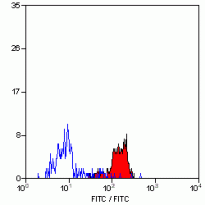ARG22465
anti-CLEC7A antibody [2A11] (low endotoxin)
anti-CLEC7A antibody [2A11] (low endotoxin) for Flow cytometry,Functional study,IHC-Frozen sections,Immunoprecipitation and Mouse
Overview
| Product Description | Azide free and low endotoxin Rat Monoclonal antibody [2A11] recognizes CLEC7A This antibody recognizes murine beta-glucan receptor, also known as Dectin-1.Dectin-1 is predominantly expressed by cells of the monocyte/macrophage and neutrophil lineages, but also at lower levels by dendritic cells and a subpopulation of T cells.As a major leucocyte receptor for beta-glucan this molecule may have a key role in the immunomodulatory effects of beta-glucans and in the host response to fungal pathogens. Dectin-1 may stimulate reactive oxygen production in macropahges via the protein tyrosine kinase known as Syk. Rat anti Mouse Dectin-1 antibody, clone 2A11 inhibits the binding of zymosan to macrophages via the beta-glucan receptor. |
|---|---|
| Tested Reactivity | Ms |
| Tested Application | FACS, FuncSt, IHC-Fr, IP |
| Host | Rat |
| Clonality | Monoclonal |
| Clone | 2A11 |
| Isotype | IgG2b |
| Target Name | CLEC7A |
| Antigen Species | Mouse |
| Immunogen | Dectin-1 transfected NIH3T3 cells and recombinant soluble Dectin-1. |
| Conjugation | Un-conjugated |
| Alternate Names | C-type lectin superfamily member 12; CD369; Dectin-1; Dendritic cell-associated C-type lectin 1; CLECSF12; CANDF4; BGR; Beta-glucan receptor; C-type lectin domain family 7 member A; DC-associated C-type lectin 1; DECTIN1 |
Application Instructions
| Application Suggestion |
|
||||||||||
|---|---|---|---|---|---|---|---|---|---|---|---|
| Application Note | IHC-Fr: The epitope recognised by 2A11 is sensitive to H202 treatment, therefore quenching with 0.3% H202 should be performed after incubation with the primary antibody. The epitope recognised by this antibody is reported to be sensitive to formaldehyde fixation and tissue processing. Arigo recommends the use of acetone fixation for frozen sections. FACS: Use 10ul of the suggested working dilution to label 10^6 cells in 100ul * The dilutions indicate recommended starting dilutions and the optimal dilutions or concentrations should be determined by the scientist. |
Properties
| Form | Liquid |
|---|---|
| Purification | Purification with Protein G. |
| Purification Note | Low endotoxin |
| Buffer | PBS |
| Concentration | 1 mg/ml |
| Storage Instruction | For continuous use, store undiluted antibody at 2-8°C for up to a week. For long-term storage, aliquot and store at -20°C or below. Storage in frost free freezers is not recommended. Avoid repeated freeze/thaw cycles. Suggest spin the vial prior to opening. The antibody solution should be gently mixed before use. |
| Note | For laboratory research only, not for drug, diagnostic or other use. |
Bioinformation
| Database Links |
Swiss-port # Q6QLQ4 Mouse C-type lectin domain family 7 member A |
|---|---|
| Gene Symbol | Clec7a |
| Gene Full Name | C-type lectin domain family 7, member a |
| Background | This gene encodes a member of the C-type lectin/C-type lectin-like domain (CTL/CTLD) superfamily. The encoded glycoprotein is a small type II membrane receptor with an extracellular C-type lectin-like domain fold and a cytoplasmic domain with an immunoreceptor tyrosine-based activation motif. It functions as a pattern-recognition receptor that recognizes a variety of beta-1,3-linked and beta-1,6-linked glucans from fungi and plants, and in this way plays a role in innate immune response. Alternate transcriptional splice variants, encoding different isoforms, have been characterized. This gene is closely linked to other CTL/CTLD superfamily members on chromosome 12p13 in the natural killer gene complex region. [provided by RefSeq, Jul 2008] |
| Function | Lectin that functions as pattern receptor specific for beta-1,3-linked and beta-1,6-linked glucans, such as cell wall constituents from pathogenic bacteria and fungi. Necessary for the TLR2-mediated inflammatory response and for TLR2-mediated activation of NF-kappa-B. Enhances cytokine production in macrophages and dendritic cells. Mediates production of reactive oxygen species in the cell. Mediates phagocytosis of C.albicans conidia. Binds T-cells in a way that does not involve their surface glycans and plays a role in T-cell activation. Stimulates T-cell proliferation (By similarity). [UniProt] |
| Calculated MW | 28 kDa |
| PTM | Phosphorylated on tyrosine residues in response to glucan binding. |
Images (1) Click the Picture to Zoom In






